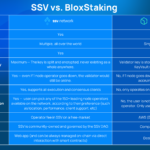The future of the Ethereum blockchain is one of the most promising and exciting topics in the crypto universe. The future roadmap unravels a beautiful new approach to adding speed, scalability and solving many of the challenges facing the ecosystem.
Transitioning to Proof of Stake
Leaving PoW Behind
Proof of Stake is transforming the way trust mechanisms are applied to future and upgrading blockchains, most notably, Ethereum. It was never a secret that Proof of Work has severe limitations and consumes outrageous amounts of energy. Small and medium sized outfits are no match for the large operations that continue to dominate the network. While secure, the original Ethereum was doomed to be replaced and upgraded with something bigger, bolder and incredibly more fast – the Eth2 Beacon Chain.
The Beacon Chain
The PoW based Ethereum 1 chain will run in parallel (and be bridged) to a new blockchain, the Eth2 Beacon Chain. Initially, the Beacon Chain will manage the registry of validators and once shard chains are introduced, it will be responsible for syncing data across all of the chains. Communication between Eth1 and the Beacon Chain allows legacy blocks to maintain operations and ensure continuity without erasing the history of blockchain data, transaction records and asset ownership.
Those that wish to participate in supporting the network have an opportunity to replace crypto mining with crypto staking, a more efficient, secure and potentially lucrative approach to blockchain consensus.
RUN A Validator, Support The Network
Running A Validator
The basic requirements needed to help secure the network are 32 ETH, and the correct technical infrastructure OR a staking service (custodial or non-custodial).
Supporting Eth2 Grow
In order for the network to operate, validators deposit and stake in multiples of 32 ETH and take turns proposing and attesting blocks. Validators earn rewards, while adding blocks to the chain, which is the basic revenue model for Eth2.
Anyone Can Do It
The barriers to entry for contributing to the growth of Ethereum are shrinking, as running a validator is open to anyone and staking services are being developed to assist. Much more accessible than the mining world today.
Staking & Rewarding
Rewards For The Taking
Eth2 staking supports the security and efficiency of the network and also opens up a new opportunity to generate impressive benefits from idle Ether. This reward mechanism makes staking a pretty attractive offer.
Early Bird Gets The Stake
The more active validators are operating on the network the less each validator is rewarded on average. Early staking players will get to enjoy more benefits. Anyone can calculate how much benefits they can get by staking, using an online ETH rewards calculator.

The above graph shows that early stakers will have a potential upside of rewards on their staked ETH.
The Risk For The Reward
It’s important to state that staking and running a validator is not without risks. Security and penalty mechanisms exist to prevent actors from performing harmful operations on the Beacon Chain.
Such operations could be malicious attacks, for which slashing may occur, or prolonged time spent offline. Though a much less severe penalty, validators may face deductions in staked ETH if they are not attesting and proposing blocks regularly when called upon.
The Sharding Protocol
Sharding Fundamentals
In order for the network to efficiently scale, shard chains will be introduced in later Phases of Eth2.
In Eth1, every node stores a duplicate of all the blockchain data, resulting in slowly processed operations based on block size and node performance. This imposes restrictions on speed and scale but enforces a secure network.
The integration of sharding will partition the blockchain’s data across many parallel and integrated blockchains. With a sufficient supply of nodes, the network can guarantee that all of the data and information is readily accessible. By doing so, the network can be secured while ensuring throughput and usability for the end user.
Speed Meets Scale
The holy grail would be to exponentially multiply the current throughput of Eth1 and reach 10,000+ transactions per second (tps). This is theoretically possible with the shard chains and we will soon find out as we move towards Eth2 Phase 2.


